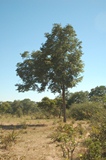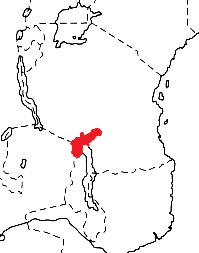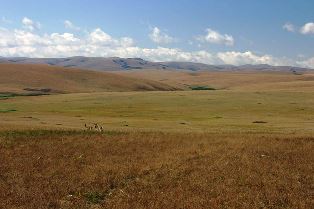Weaver species
Choose different species from drop-down list and press 'Go' button. See Full species list.Mountain Marsh Widowbird Euplectes psammocromius
IUCN: Least concern Discovery: 100Categories: long tail,
News items about species
Discovery
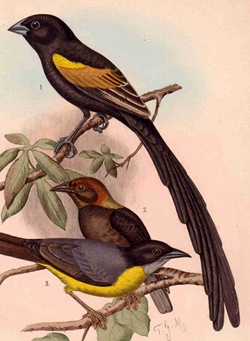
figure from Reichenow (1902) 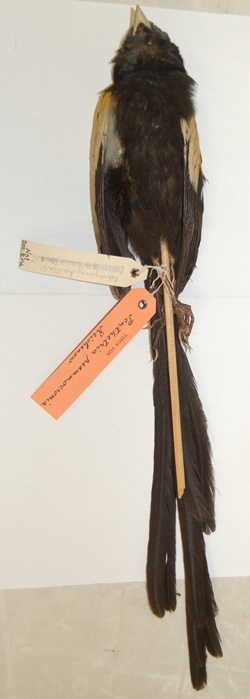
figure from Mackworth (1955) 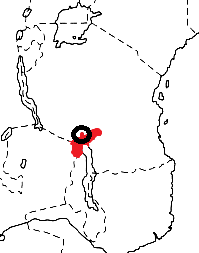
distribution, type locality circled IntroductionThe Mountain Marsh Widowbird was formally described by Anton Reichenow, a German ornithologist and herpetologist.The Mountain Marsh Widowbird was collected by Friedrich Fulleborn, a Prussian physician. Fulleborn studied medicine and natural sciences in Berlin. From 1896 onward, he was a military physician assigned to the Schutztruppe in German East Africa (Tanzania). In 1898-1900 he participated in the Nyassa- and Kingagebirgs Expedition to southern Tanzania, where he conducted anthropological and ethnographic research. He also collected bird specimens, which he sent to Berlin. In 1899 he collected birds in the region north of Lake Malawi (but in Tanzania), a region not explored ornithologically until then. Fulleborn found the type of the Mountain Marsh Widowbird at Tandala in Ukinga, Tanzania. The first illustration of the Mountain Marsh Widowbird was of an adult male, published by Reichenow (1902). The next illustrations were published much later, from the 1980s onwards. Scientific citationPenthetria psammocromia Reichenow 1900b, Orn. Monatsb. 8 p.39, Tandala in Ukinga, Tukuyu district, south-western Tanganyika.Meaning of namespsammocromius, Greek: Psammos, sand; khroma, complexion or colour; reference to its yellow shoulder patch.First English nameFulleborn's Marsh Whydah (Shelley 1905b).Alternate namesBuff-shouldered Widowbird, Montane Marsh Widowbird, Montane Widowbird, Mountain Marsh Whydah, Nyasa Marsh-Whydah.CollectorFriedrich Fulleborn.Date collected2 May 1899.Locality collectedTandala in Ukinga, Tanzania.Type specimensThe type is in the Berlin Museum (ZMB_2000.8146). |
The above is based on Weaver Wednesday 2, a weekly series about the discovery of each weaver species.
This species text first appeared as
Weaver Wednesday [217] - Discovery [100]: Mountain Marsh Widowbird on 2016-08-10
1. Basic biology
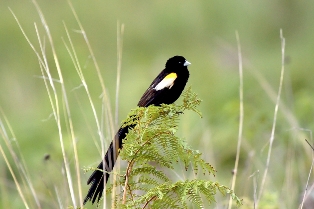
figure courtesy of Stuart Webb 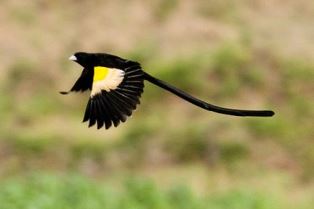
figure from wikipedia The non-breeding male is dull coloured but retains the shoulder patches. The female and sub-adult are much larger and more heavily streaked below than other widowbirds in their range. Distribution.
The Mountain Marsh Widowbird is restricted to the Nyika Plateau in Zambia and Malawi, and to the highlands of SW Tanzania to Njombe and Iringa, where it is locally common (see map below, based on Birds of Africa). It was formerly treated as a race of the Marsh Widowbird, but its habitat, geographic isolation, and distinct voices separates it as a species.
Habitat. The Mountain Marsh Widowbird inhabits short, thick, montane grassland usually near streams. It is found in pairs or small groups, but forms large flocks in the non-breeding season. Food.
The Mountain Marsh Widowbird feeds on grass seeds and insects.
Breeding. The Mountain Marsh Widowbird is territorial and is probably polygynous. The male displays in a slow flight over grasslands, with his long tail conspicuous. The nest is simialr to that of other widowbirds in being a dome-shaped structure of fine grass, and loosely woven with a side entrance. The nest is built with living grass as part of the nest. The clutch size is 2 eggs, which are pale olive-green, and densely marked with very flne brown spots and streaks. Nothing else is known about breeding. |
The above is based on Weaver Wednesday, a weekly series about weaver species.
This species text first appeared as
Weaver Wednesday [102]: Mountain Marsh Widowbird on 2014-05-28
2. Breeding facts
| Pair bond Presumed polygynous Breeding season May in Tanzania, Jan in Zambia md Oct-Nov in Malawi Nest site incorporating living grass, often within 20 cm of ground Nest building No information Colony size No information Clutch size 2 eggs Egg colour pale olive-green, densely marked with very fine brown spots and streaks Egg size No information Incubation No information Chicks and nestling period No information |
Breeding information based on Handbook of the Birds of the World, Vol. 15.
3. Photos of Weaver Nests
No records yet - be the first to submit a PHOWN record!See PHOWN summary page for this species here.
PHOWN (Photos of Weaver Nests) provides valuable info on breeding distribution and colony sizes of weavers.
You can contribute by registering and submitting photos at Virtual Museum webpage.
4. Breeding distribution
Google map showing distribution (For species with small ranges you need to zoom in at the correct area to see the range):
yellow blob - range of weaver species; read more about this here.
![]() - PHOWN records with photos
- PHOWN records with photos
![]() - PHOWN records with no photos (Nest Record Cards, other records)
- PHOWN records with no photos (Nest Record Cards, other records)
![]() - Birdpix records
- Birdpix records
![]() - comments on out of range records, or interesting records
- comments on out of range records, or interesting records
![]() - type locality
- type locality
CLICK on the marker on the map to see individual record details.
5. Range changes
Not South African speciesThe above is based on Weaver Wednesday 3, a weekly series about range changes in South African weaver species.
This species text first appeared as
n/a








